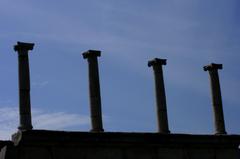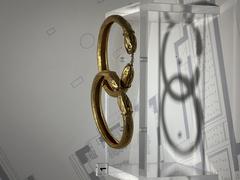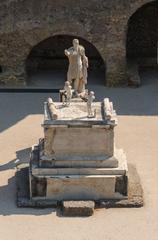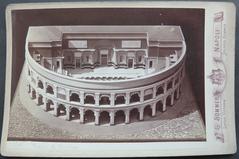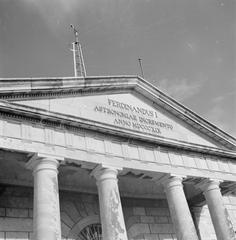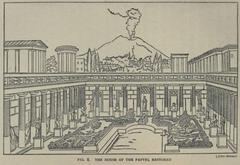Galba’s House Herculaneum: A Complete Visitor’s Guide
Date: 14/06/2025
Introduction
The House of Galba (Casa di Galba), situated in the ancient city of Herculaneum, is a standout example of Roman elite domestic architecture. Preserved by the catastrophic eruption of Mount Vesuvius in AD 79, it offers a vivid portal into the artistry, opulence, and everyday rhythms of Roman upper-class life. Thanks to Herculaneum’s unique preservation—including stone, wood, and even foodstuffs—visitors can experience an extraordinary level of authenticity when exploring this site (Herculaneum Tour Guide; Tripates).
This guide provides a detailed overview of Galba’s House, covering its historical context, architectural features, artistic highlights, and practical details such as visiting hours, tickets, accessibility, and travel tips. Whether you’re a history enthusiast, architecture lover, or a curious traveler, the House of Galba is an essential stop in your exploration of Italy’s archaeological treasures.
Contents
- Historical Context
- Architectural Layout and Features
- Artistic Highlights
- Preservation and Archaeological Importance
- Visitor Information
- Hours and Tickets
- Accessibility
- Getting There and Services
- Visiting Tips
- Frequently Asked Questions (FAQ)
- Conclusion
- Internal and External Links
- Sources
Historical Context
Herculaneum was a favored seaside retreat for Roman elites, blending Oscan, Samnite, Greek, and Roman influences (historyandarchaeologyonline.com). The House of Galba, located in Insula VII, is named after Emperor Galba (r. 68–69 AD)—although there is no evidence he ever owned it. Its location along Herculaneum’s grid-like streets signals its prominence among the city’s upper class.
Unlike Pompeii, Herculaneum was engulfed by pyroclastic flows that preserved not only buildings but also organic materials. This unique preservation makes sites like the House of Galba invaluable to researchers and visitors alike (roman-gardens.github.io; HistorySkills).
Architectural Layout and Features
Urban Setting
The House of Galba occupies a small but significant portion of Insula VII. Its original entrance, now buried, likely opened onto Cardo II, while today’s visitor entrance is on Cardo III (herculaneum.uk). The site’s layout follows the Roman urban plan, featuring parallel streets (Cardo III, IV, V) crossed by Decumano Inferiore and Decumano Massimo (nomadepicureans.com).
Main Features
- Peristyle Garden: The heart of the house is a peristyle courtyard, surrounded by twelve stuccoed tufa columns and a low wall. This area was the hub of family and social activity.
- Cross-Shaped Pool (Impluvium): The signature feature of the house is the large, marble-faced, cruciform pool at the peristyle’s center. This pool may have served as a water reservoir, fish pond, or luxurious private bath (Pompeii Tours).
- Atrium and Reception Rooms: The fauces (entrance corridor) leads into an atrium, then into the peristyle. Surrounding rooms include cubicula (bedrooms), triclinia (dining rooms), and service areas, all reflecting a typical Roman domus (roman-gardens.github.io).
- Decorative Details: The walls feature Fourth Style frescoes in vivid colors; floors are adorned with intricate mosaics and marble inlays.
Preservation of Organic Materials
Herculaneum’s rapid burial preserved wooden elements such as doors, window frames, and possibly furniture—an archaeological rarity (Visit Pompei Vesuvio).
Artistic Highlights
- Frescoes: The House of Galba’s frescoes depict mythological scenes, landscapes, and geometric motifs, showcasing the popular art trends of the 1st century AD (UNRV).
- Mosaics: Main rooms feature elaborate mosaic flooring, often with marine motifs and scenes of daily life.
- Marble and Stucco: High-quality marble and stucco were used throughout the house, signaling the wealth and taste of its owners.
- Artifacts: Finds from the house—including a silver bust of Galba—are displayed at the National Archaeological Museum in Naples (ermakvagus.com).
Preservation and Archaeological Importance
The House of Galba is partially excavated, with its main entrance still buried. The exceptional preservation of both structural and organic materials provides invaluable information on Roman domestic life, architecture, and social structure. Ongoing research and conservation efforts continue to reveal new insights (tripanthropologist.com).
Visitor Information
Hours and Tickets
- Opening Hours: Daily, 8:30 AM – 7:30 PM (last entry at 6:00 PM). Hours may vary seasonally; always check the official website for updates.
- Tickets: Standard admission €13; reduced €7 for EU citizens 18–25; free for children under 18 and EU citizens over 65. Combined tickets with Pompeii available. Tickets can be purchased online or on-site (alongdustyroads.com).
- Guided Tours and Audio Guides: Available on-site and through official apps, with specialized tours for accessibility needs (evendo.com).
Accessibility
Herculaneum is more accessible than Pompeii due to its smaller size and flat terrain (disabledaccessibletravel.com). Wheelchair users can enter via Cardo III, where ramps and accessible routes have been installed, though some uneven surfaces remain. Accessible bathrooms and maps are available; assistance can be arranged at the entrance (naplesinsider.com).
Getting There and Services
- Transport: The Circumvesuviana train connects Naples and Sorrento; Ercolano Scavi station is a short walk from the entrance. Parking is available but limited (alongdustyroads.com).
- Facilities: Information desks, rest areas, disability-friendly bathrooms, and educational panels are provided throughout the site (evendo.com).
Visiting Tips
- Wear sturdy shoes due to some uneven surfaces.
- Arrive early for a quieter experience.
- Bring sun protection and water, especially in summer.
- Combine your visit with nearby attractions like the Villa of the Papyri and House of the Stags.
- Consider a museum visit in Naples for artifacts from the site (ermakvagus.com).
Frequently Asked Questions (FAQ)
Q: What are the opening hours?
A: Daily, 8:30 AM – 7:30 PM (last entry at 6:00 PM). Check the official site for seasonal updates.
Q: How do I buy tickets?
A: Online in advance or at the entrance. Combined tickets with Pompeii are available.
Q: Is the House of Galba wheelchair accessible?
A: Partially. Ramps and accessible routes exist via Cardo III, but some uneven terrain remains.
Q: Are guided tours available?
A: Yes, both general and specialized tours are offered.
Q: What is the cross-shaped pool?
A: The impluvium at the peristyle’s center—possibly a reservoir, fish pond, or private bath.
Conclusion
The House of Galba is a must-see for anyone interested in Roman history, architecture, or daily life. Its rich artistry, unique structural features, and exceptional preservation make it a highlight of any visit to Herculaneum. By planning ahead and utilizing available resources like guided tours and digital maps, you can enjoy a rewarding, accessible, and immersive experience. For more tips and interactive content, download the Audiala app and stay updated via our social media channels.
Internal Links
External Links
- Herculaneum Tour Guide
- Tripates Herculaneum Visit Tips
- Roman Gardens - Casa di Galba
- Pompeii Tours - Herculaneum Attractions
- Visit Pompei Vesuvio
- History and Archaeology Online
- HistorySkills - Herculaneum
- Ermakvagus - House of Galba
- Disabled Accessible Travel
- Naples Insider Accessibility Guide
